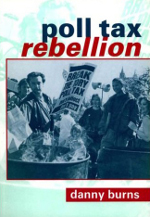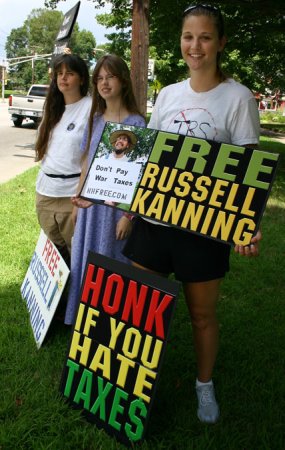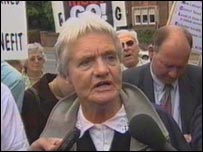
Danny Burns’s book Poll Tax Rebellion (AK Press, 1992) tells the story of the grassroots tax resistance campaign that sank the poll tax in Britain and dragged Margaret Thatcher’s decade-long reign as British prime minister down with it.
Background
Margaret Thatcher’s span as British prime minister included a paring down of the welfare state, aggressive attempts to reduce the power of organized labor, privatization and deregulation, and a flattening of the tax rate. You may recognize this deck of cards as being similar to what Ronald Reagan played with in this same time period (), and indeed the two were influenced by a similar set of economists and ideologues.
The poll tax was meant to replace local property taxes, which had been set on a local, council-by-council basis. Thatcher-aligned Conservatives disliked these property taxes, which were often raised by left-leaning local councils, and which applied only to property owners (or, indirectly, to renters). Using an argument familiar to those following current debates about the personal income tax in the United States, these critics said that because many voters did not pay these taxes, but received the benefit of the government services the taxes paid for, they were biased toward ratcheting up the tax rate to effectively confiscate and redistribute wealth from property owners, which was unfair to those taxpayers and had negative consequences in general. To fix this problem, they believed the tax should instead be applied to everybody alike. And in case the resulting voter pressure wasn’t enough to keep the rates down, the central government should have the ability to cap the poll tax and prevent spendthrift councils from raising it too far.
And so the poll tax was born. It faced immediate opposition, but at first it was unclear how this opposition would take form. The Labour party wanted people to petition and protest against the tax, but they mostly wanted people to resent it and to identify it with the Conservatives because Labour saw it as a winning issue — the party had no interest in trying to actually defeat the tax as they felt it worked to their advantage. In addition, Labour worried that if people tried to avoid the tax, for instance by not registering as residents of a tax district, they might also try to stay off the voter rolls and thus reduce Labour’s pool of potential voters.
To those targeted by the tax, though, resentment and protest were not going to be enough. For people at the bottom of the income and wealth scale, the poll tax was a considerable hit, and resistance wasn’t just an option, but a necessity. Mass-resistance to the tax was organized in a strikingly grassroots fashion, often confronting antagonism not only from the government but also from establishment opposition parties and organized labor.
The resistance to the poll tax was widespread, varied, and ultimately successful. In 1990, Thatcher resigned as prime minister and a new team took over the Conservative party and immediately flung the albatross of the poll tax from its neck, replacing it with a tiered-rate property tax.
Today I’m going to review some of the tactics that made this campaign successful.
Propaganda and spin
The very name “poll tax” was a propaganda coup for the opposition. The government had rolled out the program with the benign-sounding name “community charge,” but the “poll tax” name stuck. Poll taxes are never popular, and resistance to poll taxes has a resonance in British history with previous popular struggles.
The victims of the poll tax were a sympathetic lot, including pensioners, the disabled, poor families, student nurses, and people with elderly live-in family members, and the resistance movement was not shy about using this to its advantage.
Public burning of tax bills, and frequent leafletting and postering kept the resistance in the public eye and made sure people knew there was an ongoing resistance campaign. A community arts group created a travelling performance about the poll tax and how to resist it, and enacted it in various communities.
Take pride in resistance
Some councils tried the old trick of publishing a list of people who were behind on their taxes as a way of “shaming” them before their neighbors. Instead, when this happened, people who were resisting their taxes but who were not on the list wrote letters-to-the-editor of the periodicals where the lists appeared to ask why their names had not been included on the roster.
Myth and legend
The resistance movement summoned up images from respected tax resistance campaigns of Britain’s past as a way to make its movement seem more respectable and part of a patriotic lineage. There were references to the women’s suffrage movement and the American revolution, but even more often to Wat Tyler’s poll tax rebellion of .
The phrase “No Poll Tax Here,” seen on many of the signs and posters used by the resistance movement, also hearkened back to the Reform Act-related tax resistance of , in which people placed “No Taxes Paid Here” signs in their windows.
(The anti-poll tax resistance was so popular and successful that nowadays it is the model hearkened back to by movements like the current resistance to the Household Tax in Ireland.)
Surveys
On at least one occasion, the resistance movement took a door-to-door survey of households both to gauge their interest in resisting, and as a pretense to spread the resistance idea. One result of the surveys was that between the people who planned to pay, and the people who couldn’t or wouldn’t pay was a large (55%) middle-ground of people who were sympathetic with resistance and would be willing to resist if they knew enough people were with them. On seeing this result, Burns says, “we knew that non-payment was going to be massive.”
Another clever variety of survey was this:
[One] group then mass-produced a window poster which said “No Poll Tax Here.”
The poster was dropped through the letter-boxes of 2000 households and the group waited to see who put them up.
Posters appeared in about 100 windows.
Activists the went round and spoke to these people individually, inviting them to attend the next organising meeting…
Drown them with paperwork
Implementing the poll tax required registering everyone in the United Kingdom, and keeping track of them as they moved from one council district to another. The people who designed the poll tax program underestimated how difficult it would be to do this adequately, even if there hadn’t been a lack of enthusiasm for the project by the individual councils or outright opposition from those being taxed.
Some of the earliest resistance tactics aimed at exacerbating this problem, and the only tactic promoted by the Labour party that could be described as an actual resistance tactic falls in this category:
[The “Stop It” campaign’s] one serious initiative was the “send it back” campaign, which told activists to return the registration forms and ask awkward questions of the council officers.
Its aim was to delay the system and to make “a legitimate protest.”
Burns notes that this was of questionable effectiveness, in part because it was not pursued very vigorously, and in part because by encouraging people to register in any form — even in a temporarily obstructionist way — this provided registration information to the poll tax collecting authorities that could later be used against resisters.
Clogging the bureaucracy with paperwork was nonetheless an effective tactic, particularly later in the resistance struggle as the councils had to go through the process of pursuing those who did not pay:
…councils were inundated with correspondence.
Many people genuinely didn’t understand what the Poll Tax was about.
Others mounted campaigns to delay registration by endlessly asking questions about the form.
All of these had to be answered.
Councils sat under a mountain of paper.
Everything they did seemed to create more work.
The paper-work involved with administering the charge is enormous — and likely to get worse.
Backlogs switch from one area of activity to another.
Indeed, local authorities cannot really do anything without generating more paper-work.
If they attempt to canvas more people for registration they will also produce more people who will refuse to register.
―Poll Tax Legal Group
Make enforcement expensive
Whereas in the past, summonses issued by councils against people in arrears on their taxes had been pro forma things, rubber-stamped by judges without the summoned defendant even being expected to turn up — when people were given summonses for their poll taxes, the resistance movement encouraged them to go to court and to use whatever means they could to stretch out the time of their court appearance.
Mathematically, if even a fraction of the people summonsed actually turned up in court and were given even a few minutes of time to explain themselves, the courts would be unable to handle the load. Local Anti-Poll Tax unions trained members in the law so they could help individual resisters stand up for their rights in court.
There were frequent examples in which thousands of summons were dismissed for technical errors or just because the courts were overwhelmed.
Warn people enforcers are coming
In a strategy modeled on one used in South Africa’s apartheid-era townships, neighborhoods declared themselves “no-go” areas for sheriffs, and posted watchouts to warn people if bailiffs or other enforcers were on the way.
Activists in Edinburgh formed a group called “Scum-busters” which was equipped with CB radios and squadrons of cars.
Telephone trees were organised; bailiff companies were monitored; their car registration numbers were taken and distributed to activists in all the local areas.
The Camden group recruited taxi firms to keep an eye out for bailiff vehicles while they did their rounds and to call in their spottings.
Try to win over tax collectors and collaborators
The movement tried, without success, to convince local councils — many of which were left-leaning and not sympathetic to Conservative policies — to resign their offices, or to illegally refuse to enact their budgets according to the poll tax law. They also failed to convince the labor union representing the workers who worked in the bureau enacting the poll tax to refuse to implement the tax.
The movement had unexpected allies, of a sort, in the bailiffs who were assigned to distrain goods from tax defaulters. Being used to unorganized, ashamed, impoverished pushovers, these collection agencies were overwhelmed by organized resistance and found themselves unable to recoup the expenses of collection. For this reason some went bankrupt, while others were reluctant for merely financial reasons to handle cases of distraint for failure to pay poll tax.
Social boycott of tax collectors and collaborators
The movement also used the threat of shunning or boycott to discourage people from cooperating with the poll tax. The government tried to recruit newsstands to be deposit points for poll tax payments, as convenient supplements for government-run depots like post offices. But when the resistance movement got wind of this, “communities made it plain that they would no longer use the shops” of those who collaborated in this way.
Intimidate tax collectors and collaborators
In some cases, the intimidation went beyond threats of boycotts and shunning to vandalism and violence:
Windows have been smashed and graffiti daubed over businesses which have become agents… to collect the community charge… one agent in Patchway has now declined taking an agency after a brick was thrown through his window… [another] had the words “Poll Tax scab” and “you’re the first” scrawled in white paint across his window.
A Circle K store in Cardiff… had its door locks jammed with superglue.
Posters implicitly or explicitly threatening bailiffs and judges with lynch mob justice were not uncommon:
One showing a vicious dog, read “Bailiffs? Make my day!”
Another showing a picture of Malcolm X holding a machine gun [sic] looking out from behind the curtains, read: “Bailiffs we’re ready.”
A third showed a picture of a bailiff swinging in a noose.
It read “Dead bailiffs don’t knock on doors.”
In some areas bailiffs and registration officers were photographed and their portraits were reproduced on posters which read “wanted” and listed their “crimes.”
Some canvassers quit their jobs under the pressure of such violent threats, and one committed suicide with his family blaming it on being “sworn at and threatened” by those he encountered. On one occasion, molotov cocktails were thrown at an (unoccupied) poll tax office.
A large group of protesters converged on and surrounded the home of the head of a bailiff company. Finding him not at home, but his garage door open, they held a mock auction of his property.
Destroy or disable collection apparatus
There is one plausible story in the book of a poll tax office’s database being compromised and a large percentage of registered people being deleted from the system. On one occasion, a bailiff’s vehicle had its tires slashed. On another, resisters occupied the poll tax office, took up stations at the payment windows, and told people who had come by to pay their taxes to go home instead as the tax had been rescinded.
Blockades, occupations, and barricades
Several attempts by bailiffs to seize property from resisters were foiled by blockades of hundreds of protesters, several deep, surrounding the resister’s home and preventing access. Sometimes this would extend to barricading the streets of a neighborhood, and in at least one case, of an entire town.
There were also several examples of groups of protesters occupying government and law-enforcement offices, courtrooms, and council chambers in such a way as to make business there come to a halt.
Publish and distribute how-to guides
A group of legal advisors assembled a series of bulletins and a how-to guide to help people become familiar with their legal rights and with the process the law was likely to take in their cases. This gave them the confidence to pursue their resistance up to the limits of their comfort level, and also the techniques to make their resistance most effective.
Census resistance
Non-registration was as important as non-payment, and had to be pushed early in the campaign, while the Labour and other mainstream liberal opposition was still advising people to register but be angry about it.
When resisters were served with a liability order, it would be accompanied by a questionnaire that included questions about the resister’s employment (which could be used to help the government seize the resister’s paycheck). Although it was legally mandatory to fill out these questionnaires, and penalties were threatened against those who refused, only about 15% of the people who received such questionnaires returned them.
Engender and maintain activism and solidarity
Everybody potentially had a role to play in the resistance. People who did not owe tax could be legal advisors or join phone banks. Even children served as lookouts to watch for bailiffs.
The most successful groups used a bottom-up organizing model, where most decisions were made independently in small, locally-convened groups of resisters. This served to empower individuals and to encourage them to rely on their own initiative rather than on the decisions of a far-off activist elite.
Here’s an interesting technique for bringing people together:
An independent television company approached the Easton group in order to work with us on a film about the Poll Tax.
The film was never shown, but the way the community was engaged in the process of making it is instructive.
The film producers wanted a shot of all the doors in the street, opening one by one as the occupants came out of their houses with banners and signs.
Charles, the local street rep, went round to people’s houses every evening for a week and explained to them what was wanted.
Out of 30 houses in the street (a cul-de-sac) 28 agreed to participate.
The street is multi-racial with a fairly wide class mix.
It was inspiring to see white working class men standing shoulder to shoulder with Asian women and their kids, holding the same banners and engrossed in conversation.
Some of them had never spoken to each other before.
…[V]irtually every one of those households joined the Union, and most still had posters in their windows a year later.
People were brought into the campaign, not through a leaflet or a canvasser, but through an interesting activity.
They didn’t have to go to the campaign, it came to them.
Support and assist arrested & imprisoned resisters
When people received summonses, they could call a hotline number to get an information package in the mail. These numbers were posted on walls and utility poles all over. Volunteers were given legal training so that they could help summonsed people as informal legal advisors, and a more formal and credentialed legal advisory group in turn advised them.
Brian Wright, the first resister imprisoned for failure to pay, got 800 cards and letters from well-wishers while in jail, and hundreds demonstrated outside his cell.
The police cracked down on anti-poll tax demonstrations, in what seemed to the demonstrators like a deliberate attempt to turn them into bloodbaths, intimidate people from participating, and divide the movement into “lawless” and “respectable” factions. This seemed to work to some extent, at first, as some prominent spokespeople for the anti-poll tax movement distanced themselves from those arrested for “rioting.” But an independent group formed and dedicated itself to defending anyone arrested at these demonstrations, and organized itself in such a way as to be solely representative of the defendants (not of any other organization). Volunteers were sent to every police station to welcome demonstrators as they were bailed out, and the organization was able to share resources (like videotape disproving police testimony) and tactics among legal teams representing different defendants.
…a prisoners support group was set up… supporting 27 long-term prisoners. …
The TSDC made sure each prisoner was written to at least once a week by members of the campaign and visits to prisoners were coordinated through the campaign.
Those who had been inside offered support and advice to those who were about to be convicted, and a newsletter was produced which published the letters of prisoners.
The campaign… paid for newspapers and books; a Walkman cassette player for every prisoner; £10 a month income (the maximum they are allowed).
In addition to this some of the families were offered limited financial support for visits…
Conclusion
The resistance campaign that defeated the poll tax was diverse and creative in its tactics, and its success makes it a model worth learning from. Danny Burns’s book about the campaign is a helpful overview of these tactics and of the dynamics of how they were applied.


